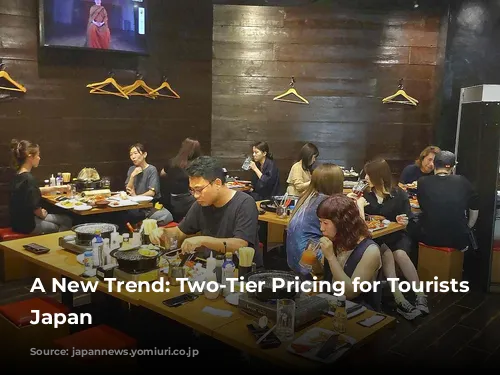Japan’s tourism industry is booming, with a surge in foreign visitors after the easing of COVID-19 restrictions. This influx has revived many tourist attractions and eateries across the country. The recent drop in the value of the yen has made Japan a bargain destination for foreign travelers, leading to a new trend of businesses charging higher prices for tourists than for Japanese nationals and residents.
This two-tier pricing system has sparked debate, with some businesses arguing that it’s necessary to offset the increased costs of providing services to foreign visitors, while others believe it’s discriminatory and could damage Japan’s reputation as a welcoming destination.
The Rise of Two-Tier Pricing
- A seafood and barbecue restaurant in Tokyo, Tamatebako, has implemented a two-tier pricing system for its all-you-can-eat buffet. Foreign tourists pay ¥7,678 for lunch and ¥8,778 for dinner, while Japanese nationals and residents receive a ¥1,100 discount.
- A Taiwanese tourist who visited Tamatebako said he didn’t mind the price difference, finding the food delicious and the service excellent.
- The restaurant’s president explained that the higher prices for foreigners are due to the increased labor costs associated with providing multilingual service and explanations.
- The restaurant employs staff who speak English to assist foreign customers with navigating the buffet and grilling their food.

The Controversial Case of Himeji Castle
- Himeji Castle, a World Heritage site, is considering raising admission fees for foreign tourists fourfold, charging them approximately $30 while Japanese residents would pay about $5.
- The mayor of Himeji argues that the fee hike is needed to secure funds for the castle’s upkeep and maintenance, including training workers in traditional skills like roof tiling and plastering.
- He claims that setting different prices for foreigners is a global standard, pointing to examples like the Taj Mahal in India and the Louvre Museum in France.
Divided Opinions and Expert Perspectives
- Opinions on two-tier pricing vary among local governments. The mayors of Osaka and Nagoya have expressed concerns about the potential negative impact on tourism.
- Osaka’s mayor said he’s considering two-tier pricing as an option, while Nagoya’s mayor is against it, believing it could deter foreign visitors.
- Kyoto’s governor is cautious, stating that a price difference needs a clear justification.
- Tourism experts acknowledge the increased costs of serving foreign visitors but caution against implementing two-tier pricing in non-profit tourist facilities.
- Professor Masafumi Tsukamoto emphasizes the need for local governments to clearly explain why they are charging foreign visitors more.
- Mitsuo Fujiyama, an expert on the tourism economy, suggests a broader discussion about how to fund the increasing costs of tourism facilities. He believes that transparency about fee increases and how the revenue will be used could make two-tier pricing more acceptable.
Conclusion
The debate surrounding two-tier pricing highlights the complex challenges facing Japan’s tourism industry as it recovers from the pandemic. While some businesses argue that higher prices for foreigners are necessary to cover the costs of providing service, others see this as discriminatory and potentially damaging to Japan’s tourism reputation. The issue requires careful consideration and a transparent approach that ensures fairness and welcomes visitors from all over the world.

